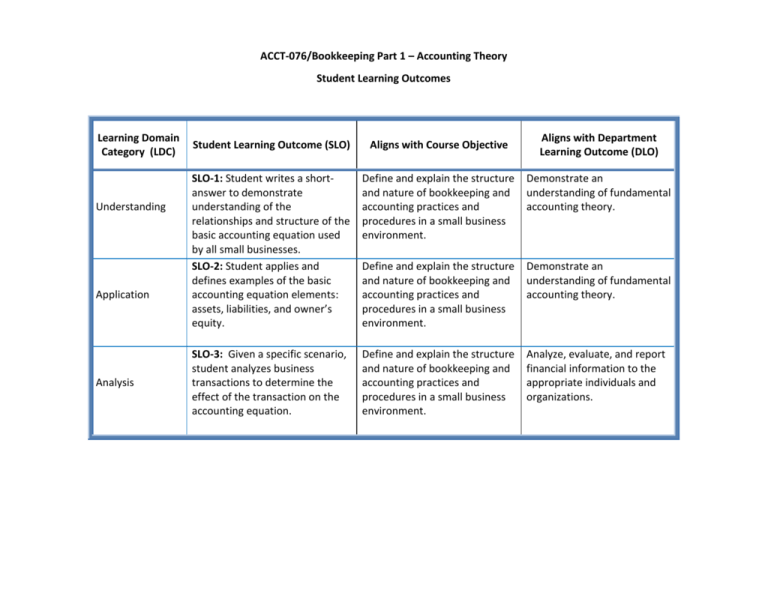ACCT076 SLOs and Rubric
advertisement

ACCT-076/Bookkeeping Part 1 – Accounting Theory Student Learning Outcomes Learning Domain Category (LDC) Understanding Application Analysis Aligns with Department Learning Outcome (DLO) Student Learning Outcome (SLO) Aligns with Course Objective SLO-1: Student writes a shortanswer to demonstrate understanding of the relationships and structure of the basic accounting equation used by all small businesses. SLO-2: Student applies and defines examples of the basic accounting equation elements: assets, liabilities, and owner’s equity. Define and explain the structure and nature of bookkeeping and accounting practices and procedures in a small business environment. Demonstrate an understanding of fundamental accounting theory. Define and explain the structure and nature of bookkeeping and accounting practices and procedures in a small business environment. Demonstrate an understanding of fundamental accounting theory. SLO-3: Given a specific scenario, student analyzes business transactions to determine the effect of the transaction on the accounting equation. Define and explain the structure and nature of bookkeeping and accounting practices and procedures in a small business environment. Analyze, evaluate, and report financial information to the appropriate individuals and organizations. Assessment Rubric for ACCT-076/ Bookkeeping Part 1 – Accounting Theory This Rubric will be used to assess student learning outcomes based on learning domain categories using varying levels. Learning Domain Category (LDC) Knowledge Does Not Meet: 0 Approaches: 1-2 Meets: 3-4 Exceeds: 5 No evidence for knowledge No evidence for understand ing No evidence for application Recalls some content and definitions but not always accurately Identifies most definitions, principles, methodologies and theories accurately Explains/demonstrates ideas, concepts and principles with limited accuracy and irrelevant examples Explains/demonstrates ideas, concepts and principles with some accuracy and relevant examples Identifies significant definitions, principles, methodologies and theories accurately Explains/demonstrates ideas, concepts and principles accurately and relevant examples Applies knowledge and concepts with little consistency or accuracy Applies knowledge and concepts with some degree of consistently and accuracy Applies knowledge and reasoning with consistently and accuracy Analysis No evidence for analysis Breaks down theories, strategies, and methods into their elements with difficulty Breaks down theories, strategies, and methods into their elements with minimal difficulty Breaks down theories strategies, and methods into their elements with accuracy Synthesis No evidence for synthesis No evidence for evaluation Integrates relevant knowledge from diverse perspectives with little depth and breadth Determines with a minimal degree of effectiveness theories, policies, or choices in problem solving Integrates relevant knowledge Integrates relevant from diverse perspectives with knowledge from diverse some depth and breadth perspectives with depth and breadth Determines with some degree Demonstrates ability to of effectiveness theories, assess the effectiveness of policies, or choices in problem theories, policies, or choices solving in problem solving Understand Application Evaluation Student not present (N/A) Score: 0-5










